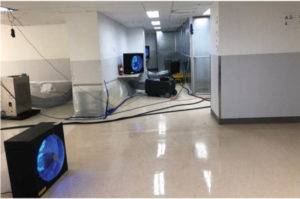Generating Pure Air
GENERATING PURE AIR
Ozone generators and hydroxyl generators both are used to remove odors, but do you know how each type works and their pros and cons?

By Johnathan McCubbin
Odors are one of those things that can be tricky. With so many different tools in your bag, which odor remedy should you choose? There are perfumes that cover up odors, chemicals that eliminate them, essential oils, gasses, and many other choices in between. Two odor control options are ozone generators and hydroxyl generators, machines with a lot of buzz around them that you might not know much about. To that end, let’s look at ozone and hydroxyl technology, its benefits, and concerns in odor control and air purification.
Where it starts
Ozone and hydroxyl chemicals are most abundant in our own atmosphere. Many people are familiar with ozone, most notably our ozone layer. Ozone is the 03 molecule, which helps block out harmful ultraviolet radiation from the sun. Without it, life on earth would be very different.
In addition to blocking ultraviolet radiation, ozone is used to break down harmful carbons and other molecules in our air. Ozone is also created during lightning storms. The sharp “zap” of lightning splits oxygen (02) and creates a reaction that leads to the formation of ozone. That is why, when you walk outside after a severe thunderstorm, the air smells “fresh.”
In addition to ozone, we have another molecule in our atmosphere that is sometimes referred to as “the scrub brush of our earth,” the OH- molecule (or hydroxyl radical). Hydroxyls are created every day by sunlight shining through clouds. Ultraviolet light reacts with the humidity in the air to create hydroxyl radicals, and these tiny little guys do a great job at keeping the air on earth clean.
Both ozone and hydroxyl radicals are oxidizers that will attach themselves to organics, odors, and molecules in the air and break them down by a chain reaction that eventually leads to carbon dioxide (CO2), oxygen and water (H20). When it comes to cleaning and restoration, companies take these processes and utilize technology to bring these naturally occurring air cleaners into our structures.
Ozone generators and hydroxyl generators are mainly used to remove odors associated with fire damage, water damage, mold remediation, household odors, and severe bio-cleanup.
First, a detailed cleaning to remove the source of the odor is recommended. Then the equipment is designed to be plugged in, turned on, and run until the job is done without any adjustments needed. While ozone and hydroxyl units provide similar results, the protocolsandsituationsfor each’s use will differ.

Ozone generators
Ozone generators have been used in the restoration industry for a long time. They are one of the staples of odor control, and most contractors have some familiarity with them.
- Time
Ozone works fast and is designed to get the job done in less than a day. The typical run time for ozone generators can range from as short as an hour up to 12 hours or more, depending on the job and severity of the odors. Ozone has a half life of roughly twenty minutes, depending on the temperature, and can build up in confined areas. This is what makes it so effective. - Effectiveness
Ozone can be produced using ultraviolet light or corona discharge. That is why we see both ultraviolet ozone generators and corona-discharge ozone generators. Note there is no “different” kind of ozone. Ozone is the 03 molecule, and the only thing that changes that is a chemical reaction. - Uses
Ozone is a great tool in contents restoration as well as typical odor jobs. Most commonly, ozone is used in homes or buildings. It is best to place the machine near a central air return, remove the air filter in the return, and turn the air conditioner and/or fan on. This will bring the ozone into the duct work and disperse it throughout the entire building. If there is no central air system, place the machine in a central location or where the most severe odors are present. Additional air movement is beneficial because we want to disperse the ozone into all areas of the structure. When it comes to contents deodorization, simply put all contents into a room or warehouse, add an air mover if possible, and run the ozone until the odors are removed. - People and pets
Within the protocol for ozone treatment, equipment operation is recommended in unoccupied areas only. The area where the ozone treatment is performed should be completely closed off and a sign should be placed at the entrance that states, “Caution: Ozone treatment in process. Do not enter.” This is because ozone is classified as an upper respiratory irritant and can affect the eyes, lungs, and throats of people and animals, but like many chemicals and equipment in an industry truck, if you follow the protocol correctly, you will have no issues.
Hydroxyl generators
Hydroxyl generators have not been around for as long as ozone generators, but they have have gained traction and gotten a lot of attention recently—and for good reason. Unlike ozone generators, hydroxyls are designed to be used in occupied areas. People, animals, plants, and anything else can stay in the areas while deodorizing with a hydroxyl generator.
For most, this is a game changer because technicians can continue to work, and the homeowner or building occupants don’t have to put their lives on hold. Insurance companies like that they don’t have to pay for hotels, meals, transportation, and other costs associated with moving out, and homeowners like that they can potentially stay in their homes and not be forced to leave. It is a win-win-win situation for all parties.
- Time and uses
As to the protocol for using hydroxyl generators it is very similar to ozone. Just like ozone, you can use them for contents and structural deodorization. Hydroxyl radicals are very short lived, highly reactive, and must be dispersed quickly to work effectively. Hydroxyls will take longer than ozone to complete a job and, on average, must run three to five days, depending on the severity of the odors.
It is recommended to place the hydroxyl generator in a central location or where the odors are most severe. A model with a built-in fan has its advantages, but adding additional air movers is always a good idea.
Because of the nature of the OH- molecule, humidity is needed at the intake of a hydroxyl generator. This is because the H20 is broken apart inside the machine to create the OH- and sent out to attack organics and compounds in the air (just like what happens in our atmosphere). Without water, you cannot create a hydroxyl radical, and with very low humidity, you are not working efficiently. While some generators are said to run in very low humidity and still create enough hydroxyls to be effective on odors, basic chemistry proves this claim wrong. - Types of hydroxyl generators
There are a few different technologies and models of hydroxyl generators out there: Photocatalytic oxidation, which uses UV-irradiated titanium dioxide, is one of the main technologies, as well as those that create and destroy ozone within a UVC chamber to create the hydroxyl radical.
Making money
Let’s get into the main question: How much money can you make with these units? Both ozone generators and hydroxyl generators can and should be billed through insurance. They both have an Xactimate code to help guide you with the amount you can bill.
Ozone is billed based on the area of the job, while hydroxyls are billed per day. Ozone can be billed though Xactimate code CLN-DODROZ at an average rate of about 5 cents per cubic foot. Hydroxyl generators can be billed through Xactimate using code CLN-DODHY at an average of about $225 per day. Overall, the equipment generally pays for itself very quickly.
Professional restoration contractors as well as cleaners who specialize in odor removal need this equipment in their arsenal as one of the tools for the job. Hydroxyl generators are designed to be used in occupied areas, including homes, businesses, schools, and hospitals where people are present. Ozone is intended for unoccupied areas. Some places to run ozone would be vacant houses or businesses, rental cars, hotel rooms, and anywhere that is unoccupied. Ozone generators and hydroxyl generators are both safe and effective when following the correct protocol.
Whether you are dealing with fire damage, water damage, household odors, bio-cleanup, or any number of other odors, either an ozone generator or hydroxyl generator is a good investment.
Reference: https://cleanfax.com/science-and-technology/generating-pure-air/


